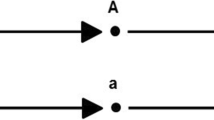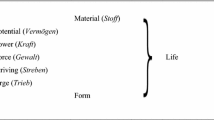Abstract
Whereas Peirce’s logic (and belief therein) drove him to postulate a primitive sentiency of physical matter, this essay argues that life exhibits behavior that is radically discontinuous from its preconditions; e.g., life manufactures chance by semiotic means. A sign being something that stands for another thing to a mind, signs are brought into existence only by acts of ‘reading.’ Peirce argued that this action is an element of physics, and thus the entire universe ‘lives.’ This essay postulates a degenerate form of Firstness that is contingent upon ‘caused’ forms of apparent but not actual chance, and which consists of possibility sans sentiency. This argument limits the range of Peirce’s semiotics to biology; chance remains radical, though its roots now lie in the coextension of semiotics and life. As living things live only by incorporating extant phenomena, continuation depends on the ability to enter into successful semiotic relationships. This results in the ‘minding’ behavior that is both biological sentiency and genuine Firstness, and which expresses radically discontinuous behavior. Thus chance becomes something akin to truth: neither exists ‘metaphysically’ (as with James’ mythic Jack of Spades), both are quite distinct from being, and both happen only as a consequence of interpretation as it is generated by and re-generates sign-wielding beings as they seek what they need to go on living. While quite distinct from Peirce, this notion of chance may well result in a more productive use of his semiotics.
Similar content being viewed by others
Notes
Variously attributed to Thomas Jefferson, Mark Twain, Stephen Leacock, etc.
Collected Papers (Peirce 1931–1935), volume 6, page 201.
See Hausman, (1993, 176).
See Parker, (1998. 227).
This depiction of Peirce’s categories places greater emphasis than some on the way in which the transactive and synechistic elements are mutually reinforced, e.g., Feibleman (1946). It is staunchly opposed by Madden (1956) who argues that the ‘essential ontology’ of Peirce is profoundly opposed by the functionalism of James. I argue that Peirce was as staunch a functionalist as James – the most significant differences between the two are largely a result of scale. See below, and Ostdiek (2010).
In the sense of Postman and Weingartner (1971).
E.g., should a child throw a ball, the minding element precedes and determines the ball’s subsequent motion no less than the non-minding elements such as mass, spin, velocity, etc.
To use Kauffman’s language (2000), chapter 3.
I mean this in the sense offered by Santayana (1955).
Much of this analysis is drawn from Turley (1969). But to be clear: I do not argue that Peirce found a trinity of genuine chance. Peirce clearly argues (and I agree) that only absolute chance is genuine chance, where as the other two forms of seeming chance do not involve any element of mind (or, in Peirce’s terms, an ideational third), and thus fail to manufacture or express any form of actual chance.
Though grounded in the notion that existence is the ‘body’ that supports (is) a ‘divine’ psychology, Panentheism is not merely a religious postulation. It also serves as an ontological claim, which is refuted by the postulation of degenerate Firstness: (see Hartshorne and Reese 1953: 499–515).
This is not contradicted by Savan (1976, 32), who notes that, for Peirce, only mental phenomena are obligatorily triadic. As argued above, Peirce considered all phenomena necessarily sentient, i.e. engaged in mental activity. I claim Savan’s argument as supporting the notion that, contra Peirce, insentient physicality as degenerate firstness can be supported by a deliberately generous reading of Peirce’s cosmology plus the notion that not all possibility involves minding behavior.
As described in Ostdiek (2011).
Such as symbols, cultures, etc. e.g., Nöth (2013).
E.g., Diamond (2005).
Tricks are not necessarily unethical. To know the tricks of your trade is generally a good thing. In the sense of Postman and Weingartner (1971), intransigent students can be ‘tricked’ into learning.
References
Diamond, J. (2005). Collapse. New York: Viking Penguin.
Emerson, R. W. (2007/1841). Essays, first series. Stilwell, KS: Digireads.com
Feibleman, J. (1946). An introduction to peirce’s philosophy. New York: Harper and Row.
Glynn, L. (2010). Deterministic chance. Br J Philos Sci, 61, 51–80.
Hartshorne, C. (1941). Charles Sanders Peirce’s metaphysics of evolution. N Engl Q, 19(51).
Hartshorne, C., & Reese, W. (1953). Philosophers speak of God. Chicago: University of Chicago Press.
Hausman, C. R. (1993). Charles S. Peirce’s evolutionary philosophy. Cambridge: Cambridge University Press.
Havel, I. M. (1996). Scale dimensions in nature. Int J Gen Syst, 24(3), 295–324.
Hoffmeyer, J. (2009). Epilogue: Biology is immature biosemiotics. In J. Deely & L. Sbrocchi (Eds.), Semiotics 2008 (pp. 927–942). Ottawa: Legas Publishing.
Kargon, R. (1964). William Rowan Hamilton, Michael Faraday, and the revival of Boscovichean atomism. Am J Phys, 32(10), 792–795.
Kauffman, S. (2000). Investigations. Oxford: Oxford University Press.
Kessler, G. (1998). A neglected argument. Proceedings of the world congress of philosophy. Boston: Paideia.
Leopold, A. (1953). Round river. Oxford: Oxford University Press.
Madden, E. (1956). Chance and counterfacts in Wright and Peirce. Rev Metaphys, 9, 420–432.
Monod, J. (1971). Chance and necessity. New York: Vintage Books.
Morowitz, H. (2002). The emergence of everything. Oxford: Oxford University Press.
Nöth, W. (2013). The life of symbols and other legisigns. In V. Romanini (Ed.), Peirce and biosemiotics (pp. 171–182). Heidelberg: Springer.
Ostdiek, G. (2010). Darwin’s ontology: the consequences of reciprocity. Diss. Charles University in Prague.
Ostdiek, G. (2011). Cast in plastic: semiotic plasticity and the pragmatic reading of Darwin. Biosemiotics, 4, 69–82.
Ostdiek, G. (2014a). Actual people, virtual praxis, and post-biotic anthropology. In P. Gibas, K. Pauknerová, & M. Stella (Eds.), Non-humans in social science III. Červený Kostelec: Pavel Mervart Publishing.
Ostdiek, G. (2014b). Signs, science and religion: a biosemiotic mediation. In D. Evers, M. Fuller, A. Jackelén, & S. Knut-Willy (Eds.), What is life? (Issues in science and theology 8. Berlin: Springer.
Parker, K. (1998). The continuity of Peirce’s thought. Nashville: Vanderbilt University Press.
Peirce, C. S. (2010). The writings of Charles S. Peirce Vol. 8, Peirce edition project. Bloomington: Indiana University Press.
Peirce, C. S. (1931–1935). The collected papers of Charles Sanders Peirce, vols. 1–6. Cambridge, MA: Harvard University Press.
Postman, N., & Weingartner, C. (1971). Teaching as a subversive activity. New York: Delta Publishing.
Russell, B. (1960). An outline of philosophy. Cleveland: Meridian Books.
Santayana, G. (1955). Skepticism and animal faith. New York: Dover.
Savan, D. (1976). An introduction to C. S. Peirce's Semiotics Part I, Toronto: Toronto Semiotic Circle.
Stoppard, T. (1967). Rosencrantz and guildenstern are dead. London: Faber and Faber.
Turley, P. (1969). Peirce on chance. Trans Charles S Peirce Soc, 5(4), 243–254.
Turley, P. (1975). Peirce's cosmic “sheriff”. J Hist Ideas, 36(4), 717–720.
Wright, C. (2000). In F. Ryan & E. Madden (Eds.), The evolutionary philosophy of Chauncey Wright, vol. 1. Bristol: Thommes.
Author information
Authors and Affiliations
Corresponding author
Rights and permissions
About this article
Cite this article
Ostdiek, G. The Manufacture of Chance: Firstness as a Fixture of Life. Biosemiotics 7, 361–376 (2014). https://doi.org/10.1007/s12304-014-9208-x
Received:
Accepted:
Published:
Issue Date:
DOI: https://doi.org/10.1007/s12304-014-9208-x




